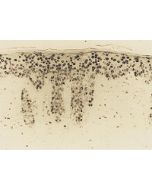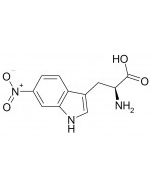Cookie Policy: This site uses cookies to improve your experience. You can find out more about our use of cookies in our Privacy Policy. By continuing to browse this site you agree to our use of cookies.
JaICA
anti-Thymidine Glycol [TG], mAb (2E8)

| Product Details | |
|---|---|
| Product Type | Monoclonal Antibody |
| Properties | |
| Clone | 2E8 |
| Isotype | Mouse IgG1κ |
| Immunogen/Antigen | Thymidine glycol polymer. |
| Application |
Immunohistochemistry: Recommended concentration is 5-10μg/mL |
| Crossreactivity |
All Human |
| Specificity |
Recognizes DNA containing thymidine glycol. Does not cross-react with oxidized dC polymer, oxidized dG polymer and oxidized dA polymer. Does not react with free thymidine glycol. |
| Formulation | Lyophilized. Contains 10mM PBS, pH7.4 containing 1.0% BSA. |
| Reconstitution | Reconstitute with 1mL distilled water. |
| Isotype Negative Control | |
| Other Product Data |
Click here for Original Manufacturer Product Datasheet |
| Declaration | Manufactured by JaICA. |
| Shipping and Handling | |
| Shipping | BLUE ICE |
| Short Term Storage | +4°C |
| Long Term Storage | -20°C |
| Handling Advice | Avoid freeze/thaw cycles. |
| Use/Stability |
Stable for at least 3 years after receipt when stored at -20°C. After reconstitution, prepare aliquots and store at -20°C. |
| Documents | |
| Product Specification Sheet | |
| Datasheet |
 Download PDF Download PDF |
Thymidineglycol (TG) is one of the major oxidation products of DNA. Thymidine (T) can be damaged by oxidative stress such as radiation and energy metabolism. Two different pathways to form TG have been suggested. Deoxythymidine in DNA is directly oxidised by hydroxy radical, to form TG. TG can be also formed through an intermediate thymidine chlorohydrin, which is derived from hypochlorous acid (HOCl) from neutrophil myeloperoxidase. Thymidineglycol is derived from DNA, not from RNA. TG is the oxidative stress marker secific for DNA damage. In comparison with 8-hydroxy-2'-deoxyguanosine (8-OHdG), which is the best known DNA oxidation product it was shown that in a lipopolysaccharide (LPS)-treated mouse liver, 8-OHdG can be stained within 24 hours after LPS treatment. TG can be detected within 6 hours, and remains at least for 72 hours.
- Serum antioxidant capacity and oxidative injury to pulmonary DNA in never-smokers with primary lung cancer: K. Ito, et al.; Anticancer Res. 32, 1063 (2012)










![anti-4-Hydroxy-2-nonenal [4-HNE], mAb (HNEJ-2)](https://adipogen.com/media/catalog/product/cache/60eb5af712bc93baae8d55513bd31b01/j/a/jai-mhn-ihc-4-hne_stain_2.jpg)
![anti-4-Hydroxy-2-nonenal [4-HNE], mAb (HNEJ-2)](https://adipogen.com/media/catalog/product/cache/60eb5af712bc93baae8d55513bd31b01/j/a/jai-mhn-ihc-4-hne_stain.jpg)